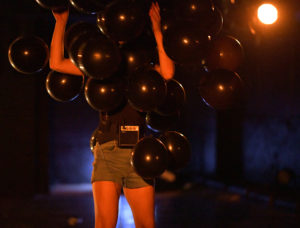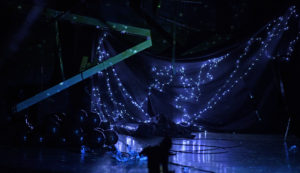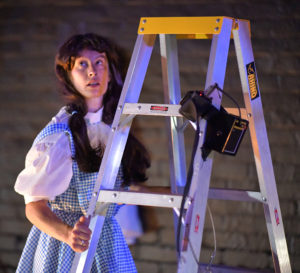Working on My Night Moves – a Glimpse of our Feminist Future (Theatre review)
Without speaking a word, Working on My Night Moves offers us a glimpse into a feminist future – one that is bold, optimistic and laced with humour and aluminium foil.
Working on My Night Moves is a one-woman show, performed by Julia Croft and directed by Nisha Madhan. With no dialogue, just occasional voice-over moments; everything is accomplished through action, with stirring musical accompaniment. Costume changes are startlingly deft, made in front of our eyes. Ladders, chairs and lights are moved about, and the basic costume of black singlet and shorts, worn both by Croft and those helping with the props, give the impression of workers moving purposefully about in an Escher drawing.

It is an impression that is enhanced by Croft’s lithe, athletic movements, the mysteriousness of the intended results, and the way scene shifters quietly emerge from, and then dissolve back into, the audience. The props, which serve to take us forward into outer space and backward into Wizard of Oz territory, then forward again, can at once be seen for what they are and transcend what they are – you see though them and buy into what is being done with them at the same time. I was reminded of the 70’s TV show Blake’s 7 – the mundane make-up of the set is obvious, but you still agree to be transported. The overall tone is bold, optimistic and laced with humour.
Working on My Night Moves is the third part of a trilogy, but it works well as a stand-alone show. It follows on If There’s Not Dancing in the Revolution, I’m Not Coming (Julia Croft, 2015, directed by Virginia Frankovich) and Power Ballad (Julia Croft and Nisha Madhan, 2017). It was developed by Julia Croft and Nisha Madhan at the Battersea Arts Centre in London, with the support of Creative New Zealand.

The trilogy is feminist-themed, and Working on My Night Moves explores possible futures, and new ways of thinking the world that spring from a feminist point of view. It is not enough to say what is wrong, you might say, you also need a glimpse of how an alternative future might be built, and Night Moves sets out to offer that glimpse. There are blurred boundaries between set changes and action, between audience and performer, which is consistent with the idea of imagined futures being “built” and hierarchical structures disbanded.
There are no chairs unless you ask for one, and the audience and no stage – the audience and the performance are on the same level. The doors open, and the audience mills in front of a black, star-spangled curtain. No one shushes them, everyone stands around, chatting freely among themselves, then drifts on into the main performance area, where the darkness is pierced by discrete lighting, the song Working on My Night Moves pours forth from the speakers, and the performance begins.

The show lasts for about an hour, which is the perfect length for taking it in as a unified whole, allowing the mix of futuristic exploration, backward glances and blurred boundaries to escape linear interpretation. The audience, whose ages appeared to cover a wide range, remained engaged and enthusiastic throughout. Once we came to the joyous, optimistic finale, any residual boundary between the audience and players had dissolved, and everyone was uplifted in unison. In that sense, the show itself works an example of the non-hierarchical, boundary fluid future it is exploring.
Working on My Night Moves is playing at the Basement Theatre until March 23rd
Tickets are available here.
Olwyn Stewart
- VÏKAE – Tы мой океан (You’re My Ocean): 13th Floor New Song Of The Day - July 27, 2024
- Tami Neilson Announces “Neilson Sings Nelson” Tour - July 26, 2024
- R.I.P. John Mayall: British Blues Pioneer Age 90 - July 24, 2024
